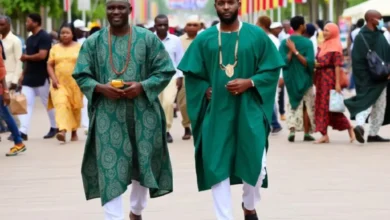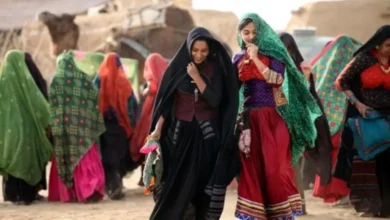Aso Ebi: A Deep Dive into Nigerian Culture and Fashion
What is Aso Ebi?
Aso Ebi, a Yoruba phrase translating to “family cloth” or “same cloth,” is more than just clothing; it’s a vibrant cultural tradition deeply woven into the fabric of Nigerian society, particularly within Yoruba, Igbo and other ethnic groups.
It represents unity, solidarity, and shared celebration. At weddings, naming ceremonies, funerals, and other significant events, guests are adorned in matching, meticulously chosen fabrics, signifying their connection to the celebrant and the occasion’s importance.
The Significance of Matching Outfits
The uniformity of Aso Ebi goes beyond mere aesthetics. The act of wearing the same fabric creates a powerful visual representation of communal identity. It underscores the collective celebration and reinforces the bonds between the celebrant’s family and their guests. This shared attire fosters a sense of belonging and participation, making everyone feel deeply involved in the event.
The choice of fabric and style often reflects the celebrant’s social status and the event’s scale. More elaborate and expensive fabrics indicate a more significant occasion or a higher social standing.
See also Agbada: The Ultimate Guide to This Majestic West African Garment
Agbada: The Ultimate Guide to This Majestic West African GarmentThe Evolution of Aso Ebi: From Tradition to Trend
While rooted in tradition, Aso Ebi has evolved significantly over time. Initially, the fabric was often simple and locally sourced. Today, it encompasses a wide spectrum of styles, fabrics, and designs, influenced by global fashion trends but retaining its cultural essence. Designers are now incorporating modern silhouettes and embellishments while preserving the traditional spirit of the Aso Ebi.
The rise of social media has further amplified Aso Ebi’s influence. Instagram and other platforms showcase the stunning designs and vibrant colors, inspiring new trends and generating significant buzz around events. This has made Aso Ebi a significant fashion phenomenon, influencing design trends globally.
The Fabrics and Styles of Aso Ebi
Aso Ebi utilizes a variety of fabrics, each with its own unique qualities and price points. Popular choices include:
- Ankara: A vibrant and widely loved cotton fabric with bold prints, Ankara is a staple in Aso Ebi creations. Its versatility allows for an array of styles.
- Lace: Elegant lace fabrics, ranging from delicate guipure to richly embellished styles, are often chosen for more formal occasions.
- Satin: With its lustrous sheen and smooth texture, satin is a luxurious choice, typically used for its sophisticated aesthetic.
- George: A durable and versatile fabric known for its rich textures and ability to drape beautifully.
- Adire: A traditional Yoruba indigo-dyed cloth, Adire offers a distinctly cultural and sophisticated option reflecting traditional craftsmanship.
Styles vary widely depending on the designer, the event, and personal preference. From flowing gowns and tailored suits to stylish jumpsuits and traditional wraps, the creative possibilities are endless.
See also Biblical Sandals: Authentic Styles & History
Biblical Sandals: Authentic Styles & HistoryThe Cost of Aso Ebi: A Social Commentary
The cost of Aso Ebi can range significantly, reflecting the social dynamics and economic considerations within Nigerian society. It’s not uncommon for the fabric and tailoring to be relatively expensive, representing a significant financial commitment from guests. This aspect has sparked debate, with some arguing that it puts undue financial pressure on guests, while others view it as a demonstration of support and celebration.
The price reflects not only the fabric’s quality but also its rarity and the designer’s reputation. Custom-made outfits by well-known designers command higher prices, adding to the social status associated with the event.
Aso Ebi and Social Status

The choice of Aso Ebi fabric and style often reflects the celebrant’s social standing and the importance of the event. Higher-quality materials and more elaborate designs signal a more significant occasion or a higher social standing of the family. This displays not only wealth, but also the family’s social connections and influence.
The event itself can also influence the choice of Aso Ebi. A grand wedding may warrant a much more luxurious fabric and style compared to a smaller, more intimate gathering.
The Role of Designers in Aso Ebi Fashion
Nigerian fashion designers play a crucial role in shaping the Aso Ebi landscape. Their creativity and innovation constantly evolve the styles and designs, introducing fresh perspectives and reinterpreting traditional aesthetics. Many prominent designers have built their careers around creating stunning Aso Ebi ensembles for high-profile events.
These designers contribute to the overall cultural significance of Aso Ebi by blending tradition with contemporary styles, attracting international attention and establishing Nigeria as a significant hub for innovative African fashion.
Aso Ebi Beyond Nigeria: Global Influence
The influence of Aso Ebi has extended far beyond Nigeria’s borders. The unique style and vibrant colors have captivated international audiences, inspiring designers and fashion enthusiasts worldwide. The trend has impacted global fashion, leading to a wider appreciation for African aesthetics and craftsmanship.
The adoption of similar traditions in other parts of Africa and the diaspora showcases the universal appeal of collective celebration and shared identity, expressed powerfully through clothing.
The Future of Aso Ebi
The future of Aso Ebi is bright, with ongoing innovation and evolution. Designers are constantly pushing boundaries, experimenting with new fabrics, techniques, and styles. The influence of social media and global fashion trends will continue to shape its trajectory. However, its core value – representing unity, solidarity, and shared celebration – will undoubtedly remain.
As Nigerian culture continues to gain global recognition, Aso Ebi will likely take on an even more prominent role on the world’s fashion stage, while retaining its powerful cultural significance within Nigeria.
Criticisms and Debates Surrounding Aso Ebi
While Aso Ebi is a cherished tradition, it’s not without its criticisms. The financial burden placed on guests has sparked debates about its accessibility and potential to exclude individuals with limited financial resources. Concerns have also been raised about the environmental impact of mass fabric production and the potential for unsustainable practices.
However, many argue that the cultural significance and social function of Aso Ebi outweigh these concerns. The tradition fosters a sense of community and shared celebration, strengthening social bonds within the Nigerian community and beyond.




